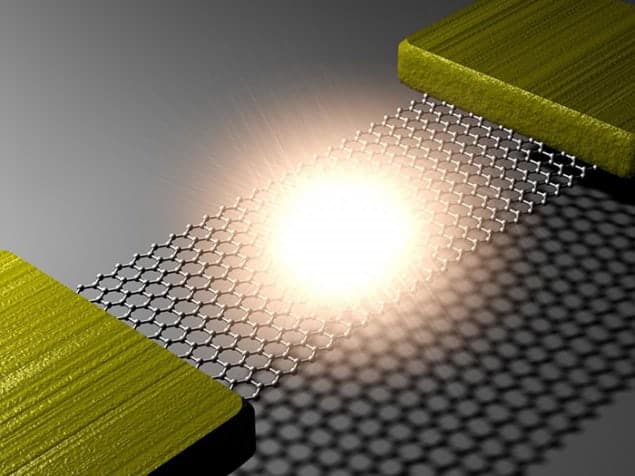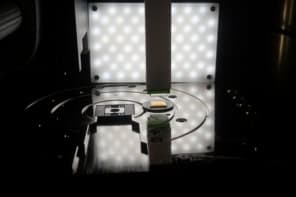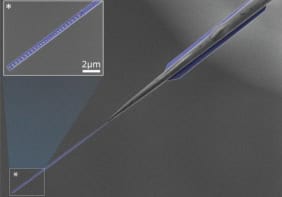
The first on-chip, visible-light source that uses “wonder material” graphene as a filament has been created by an international team of researchers. The team found that small strips of freely suspended graphene, attached to metal electrodes, can reach temperatures of up to 2800 K, allowing it to emit visible light. The research, while preliminary, opens up intriguing scientific questions, and possible applications of atomically thin, transparent, flexible displays and optical interconnects with electronic circuits.
Generating light on the surface of a chip is key to developing fully integrated photonic circuits that would, in theory, use light to carry information. In many ways, the new light source functions much like an incandescent light bulb, which glows as its wire filament is heated to a high temperature via an electrical current. Among its other remarkable properties, graphene is known for its very high thermal conductivity, but this makes it hard to heat it to extreme temperatures. Indeed, if it retained its really high thermal conductivity, it would not be possible to heat the graphene until it glowed in the visible spectrum, because the heat would flow away continuously.
Free-falling
Luckily, graphene’s thermal conductivity drops dramatically at high temperatures because of a process called “Umklapp scattering”, in which phonons scatter off one another. While graphene is normally mounted on a substrate, which acts as a heat sink to stop it from reaching such high temperatures, research done in 2006 by Andrea Ferrari of the University of Cambridge and colleagues produced the first freely suspended graphene. In the new work, the researchers attached reliable electrical contacts to suspended graphene, something Ferrari, who was not involved, describes as “much more challenging”.
The researchers were investigating suspended graphene’s potential for producing nano-mechanical oscillators. Led by Young Duck Kim then of Seoul National University, who is now at Columbia University in New York City, the team was investigating how the oscillation frequency of graphene changes with temperature by applying a variable voltage bias to heat it when Kim noticed something unusual. “During the measurement, I could see something blinking,” he says. “I realized that the blinking was light emission from the graphene.”
The heat is on
The team members fabricated multiple devices from both monolayer and multilayer graphene, and investigated their potential scalability. The researchers also tested devices made from graphene produced both by chemical vapour deposition and by the Scotch-tape method: all of them could effectively produce visible light. Based on theoretical models and analysis of the emission spectra, the researchers estimate that the temperature of the graphene at the centre of the suspended sheets was up to 2800 K.
By placing a layer of silicon behind the graphene, the researchers produced interference between light emitted by the graphene from both its front, unblocked side and the light emitted and reflected off the silicon. This led to constructive interference at some frequencies and destructive interference at others, thereby tuning the colour of the light produced. The devices are, at present, between 0.3% and 0.45% efficient – low for light sources in general but 1000 times higher than previous graphene-based radiation emitters using graphene mounted on a substrate. These earlier devices could not emit frequencies higher than infrared because of the restricted temperature of the graphene. The researchers are currently working to increase the amount of light emitted at desired wavelengths, for example by using photonic crystals and optical cavities.
Futuristic displays
The team suggests its device could have multiple applications, including in transparent and flexible lighting displays. “Graphene is well known as a transparent and flexible electrode material,” says Kim. “Now, we can also use graphene as a light source.” In addition, the researchers are investigating its potential to interface electronic circuits with optical ones – crucial to optical logic applications. “The heating and cooling are very fast,” Kim explains. “We expect to be able to turn on and off within 10 picoseconds, which means we can maybe achieve data transfer at 100 gigabits per second.”
“It’s a nice result. It’s of course a new result, but it’s not totally surprising,” says Ferrari, adding that the next step would be “to conduct similar experiments with other 2D materials such as molybdenum disulphide that may also become light emitters in this particular condition”. He is more sceptical about the potential for short-term technological application, however. “The technique [to produce suspended graphene] is very laborious,” he says. “So the question is: can this be easily mass-produced? At the moment, the answer is probably no, but in the future, one can find a way of making useful devices.” Ferrari notes, however, that, once backed with silicon, graphene ceases to be transparent, which might make transparent displays difficult.
The research is published in Nature Nanotechnology.




